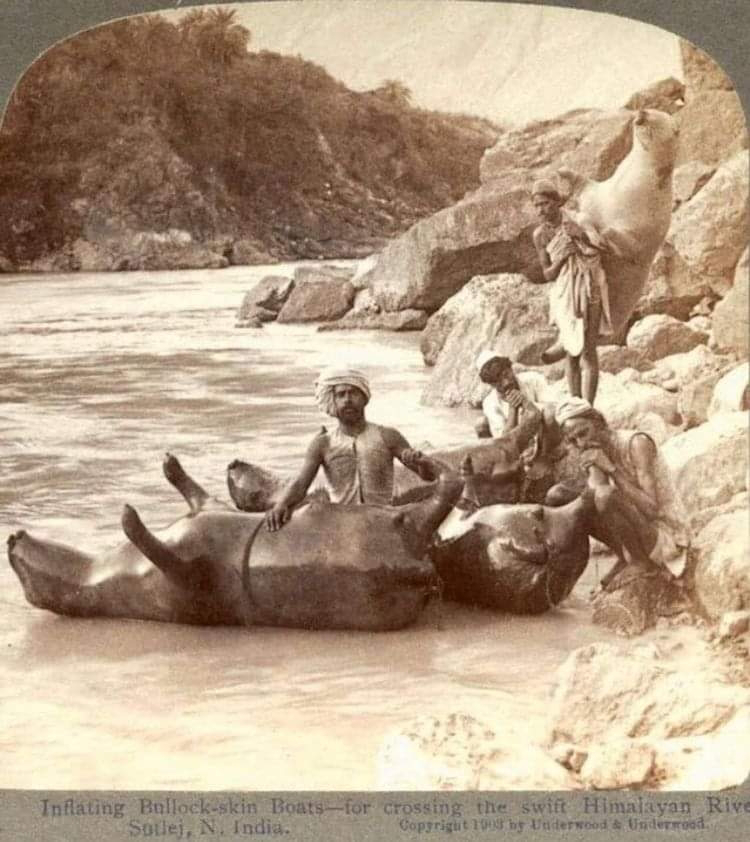The Ageless Art of Buffalo Skin Boats
Nestled amidst the breathtaking landscapes of Northern India, where the grandeur of the Himalayas meets the serpentine rivers of the valleys, a timeless tradition has persisted for generations. Along the banks of the Sutlej River, buffalo hides, ingeniously fashioned into boats, have served as not just a mode of transportation but also a source of livelihood and cultural heritage. This age-old practice bears witness to the ingenious harmony between human tradition and the natural world.
The Sutlej River:
The Sutlej River, a prominent tributary of the mighty Indus, traces its origin to Tibet, meandering through the Indian states of Himachal Pradesh and Punjab before entering Pakistan. This river, pivotal for agriculture and transport, has inspired a distinctive practice molded by its dynamic character.
Buffalo Hides: Nature's Floating Craft:
Buffalo hides, locally referred to as "bheta," form the cornerstone of this tradition. The meticulous crafting of these boats commences with the careful selection of buffalo skins. These hides undergo treatment, stretching, and skilled stitching to metamorphose into vessels that are not only resilient but also buoyant and well-suited for navigating the often unpredictable waters of the Sutlej River.
A Vital Thread in River Communities:
More than mere boats, these buffalo skin vessels are the lifeblood of the communities residing along the Sutlej River. Across generations, they have fostered trade, facilitated travel, and bridged distances, particularly in the remote regions where conventional boats might prove impractical.
A Testament to Adaptability:
A noteworthy facet of this tradition is its adaptability. Buffalo skin boats are not just resilient but also easily maintained and repaired by local craftsmen, ensuring their enduring utility. They prove their mettle in the face of the river's ever-changing temperament, from its serene stretches to its tumultuous rapids, ensuring the continued prosperity of the river communities.
Cultural Reverence:
Beyond their utilitarian significance, buffalo skin boats are deeply entrenched in the cultural fabric. They play pivotal roles in traditional ceremonies and festivals, symbolizing the river's pivotal role in the local way of life. These boats epitomize resilience and resourcefulness, virtues that have empowered these communities to confront the challenges posed by their environment.
Challenges and Preservation:
In recent times, this age-old practice of crafting buffalo skin boats has grappled with modernization, pollution, and shifts in the river's dynamics. Nonetheless, concerted endeavors are underway to safeguard this unique tradition. Both organizations and individuals are recognizing the boats' cultural value and are devoted to their preservation, ensuring the legacy and continued survival of this remarkable craft.
Legacy and Evolution:
The practice of buffalo skin boats is not static. It has evolved to incorporate modern techniques and materials while still retaining its traditional essence. Today, these boats continue to be a crucial part of the local economy and culture, connecting communities along the Sutlej River.
Conclusion:
The tradition of crafting buffalo skin boats along the Sutlej River serves as a timeless testament to the enduring bond between humanity and the natural world. It underscores the remarkable ingenuity of the riverbank communities and their capacity to adapt to the ever-changing conditions of their environment. As we gaze towards the horizon, it is imperative to acknowledge and conserve such exceptional cultural customs, not just for their practicality but also for their contribution to the rich tapestry of traditions that enrich our world. Buffalo skin boats on the Sutlej River persist as symbols of resilience, adaptability, and the indomitable spirit of those who call this river home.




Comments
Post a Comment